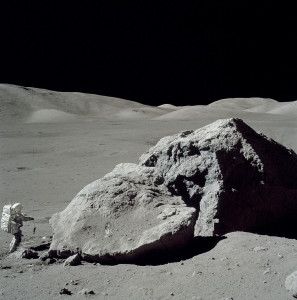Creation Corner
Energy to change a month

The Global Flood did more than change the length of the day. It changed the length of the month, or the period of the moon. Is that even feasible? Yes, once we know the Flood produced enough nuclear energy to eject three percent of the earth’s mass into space. Much of that material cost the moon enough of its energy to drop it into a lower orbit.
What is a month?
Walter T. Brown, Jr., who proposed the Hydroplate Theory of the Global Flood, calculates here how the month changed.
A month, or “moonth,” is the period of the orbit of the moon around the earth. Astronomers speak of six kinds of month. The two most relevant are:
- The sidereal month (from the Latin sidus, sideris a star) is how long the moon takes to make one orbit and appear at the same point in relation to the fixed stars.
- The synodic month is how long the moon takes to make one orbit and appear at the same point in relation to the sun.
The sidereal and synodic months would be roughly proportional. (One may safely assume such a thing for a first-order guess.)
We know two values for the synodic month. Before the Flood, it was 30 days. Today it is 29.531 days.
A month depends on the semimajor axis of the moon’s orbit, and the mass of the earth:
Energy of the moon

Scientist-Astronaut Harrison H. Schmitt (Apollo 17 LMP) stands next to a huge, split boulder during Apollo 17 EVA-3 at the Taurus–Littrow landing site on the Moon. Photo: Astronaut Eugene A. Cernan, Apollo 17 CDR/NASA
The orbital energy of the moon is the work done to bring an object from infinity into the particular orbit the object is in. By convention this expression is negative, so an object at infinity has an orbital energy of zero.
where M and m are the masses, respectively, of the earth and the moon, and G is the Newtonian gravitational constant. Henry Cavendish measured this value as:
(In so measuring, Cavendish weighed the earth, after Aristotle had found how big around the earth is.)
Both the mass of the earth and the synodic month changed. The synodic month changed from thirty (pre-Flood) “long” days to 29.531 “short” days. The mass of the earth diminished by three percent. This is the best estimate for the total mass of the “mavericks of the Solar System”: meteoroids, asteroids, comets, the small irregular moons of Mars and the gas giants, and the Trans-Neptunian objects.
But more than that, the length of the day changed. Before the Flood, a sidereal year was about 360 days (perhaps a bit longer). Today a sidereal year is 365.256 days. The year did not get longer, but the day got shorter. Brown calculates how that happened here and here.
To simplify the relationship among energy, the mass of the earth, and the length of the month (or the period of the moon), one separates the variable quantities from the constant ones. The Newtonian constant does not change, of course. But neither does the mass of the moon. (At least, not at once. A number of impactors did strike the moon centuries later, to create Oceanus Procellarum and Maria Imbrium, Frigoris, Tranquillitatis, Crisium, Humboltianum, and Moscoviense.)
First, solve for the semimajor axis a in terms of P (the month) and M:
Now substitute this expression for a in the equation for the orbital energy E. This yields:
or
or
So the orbital energy of the moon changed (ΔE/E0) by this proportion:
The mass proportion is 0.97, because the earth lost 3 percent of its mass. The proportion for the month is greater than one, because the synodic month went from 30 “long” days to 29.531 “short” days. Substituting the values, and converting between the long day and the short, yields:
Or 0.046 percent. Naturally that energy change is negative, because the period is shorter.
Is that feasible? Yes. During the 150 days of the “prevalence” of the Flood waters, a cloud of water vapor, rock and mud surrounded the earth. The moon moved through all that. The larger objects wouldn’t slow the moon down much during the Gibbous phases of its orbit (between first and last quarters). But during the crescent phases the moon would be plowing through that cloud, and subject to its full bombardment. And the moon suffered a very heavy bombardment. Even during the Gibbous phases, the water vapor itself would “aero-brake” the moon as it passed. And remember: the above formula gives the net change of energy, accounting even for the earth losing part of its mass.
The great impactors would come much later, after they’d had time to form. They hit the moon like a load of buckshot. That’s why all the great Maria (except for Mare Moscoviense on the far side, and Mare Humboltianum along the eastern terminator) formed on one side of the moon. That side turned to face the earth, in tidal lock.
Today, as Brown records, the moon has an atmosphere, about 10-14 of the thickness of earth’s. It consists of oxygen from dissociated water vapor. That is likely the most important discovery that Project Apollo, or at least Apollo 17, ever made.
This provides support for a thirty-day synodic month before the Flood. It explains why calendars have always had twelve months, and never the thirteen that the World’s Day movement tried to urge on people. (Even Will Durant, in Caesar and Christ, promoted the idea of a calendar of thirteen months of twenty-eight days each, with one intercalary day, or two every four years or so.)
Related
[subscribe2]
Terry A. Hurlbut has been a student of politics, philosophy, and science for more than 35 years. He is a graduate of Yale College and has served as a physician-level laboratory administrator in a 250-bed community hospital. He also is a serious student of the Bible, is conversant in its two primary original languages, and has followed the creation-science movement closely since 1993.
-

 Civilization5 days ago
Civilization5 days agoIlhan Omar Did Not Flee From Oppression As A Refugee – She Was Fleeing Justice & Has Been Installed To Attack – This Video Speaks Loud & Clear
-

 Guest Columns4 days ago
Guest Columns4 days agoShe Saved Her Life. 7-Eleven Fired Her
-

 Civilization5 days ago
Civilization5 days agoThis Thanksgiving, Celebrate the New Beacon of the American Dream
-

 Civilization4 days ago
Civilization4 days agoDemocrats’ Viral Video Lights Match to the Republic
-

 Guest Columns3 days ago
Guest Columns3 days agoWaste of the Day: What’s Big, Grey And Costs $350K?
-

 Civilization3 days ago
Civilization3 days agoThe AI Challenge: Palantir, the Pope, and Paul Kingsnorth
-

 Civilization3 days ago
Civilization3 days agoNo Kings, No Queens, No Blind Loyalty
-

 Executive2 days ago
Executive2 days agoWaste of the Day: California’s $450 Million 911 Center Doesn’t Work













Digg Patriots liked this on Facebook.
PolitiCollision liked this on Facebook.
Very good. At least it’s an attempt. You have repeated Dr. Brown’s calculations of the total energy of the Moon’s orbit, both currently and in his proposed pre-Flood state. The percentage difference in energy between the two orbits appears small: 0.046%. It is implied, then, that this is a trivial amount and could be accomplished by collisions with Flood material that “traveled near and roughly parallel to Earth’s orbit.” There are a number of points here worth addressing, with the upshot that you and Dr. Brown have still not have yet provided us with a realistic, physical, mathematical model for how this would actually have taken place.
First, while the _percentage_ change is indeed small, the absolute change in orbital energy is still quite large. The proposed pre-Flood Moon orbit has a whopping -3.6289c28 J of energy; post-Flood it’s -3.6280e28 J, for a difference of ~9e24 J. That’s on the order of 9 years worth of sunlight striking the Earth. That is a lot of energy to dump into the Moon, even assuming a magical process that converts all the energy of impactors into change in the Moon’s orbit rather than say heat, as I pointed out a few posts ago.
Is that too large an amount? You call it ‘feasible’ without any support other than Dr. Brown’s statements _ex cathedra_. In the link you provided, Dr. Brown simply states that that 9e24 J of orbital energy _was lost_. It is difficult to accept this at face value. There is nothing to indicate that any work has been done to justify the claim. I continue to doubt that any has been done.
Take for example Dr Brown’s assertion that the Flood material was travelling near and roughly parallel to Earth’s orbit. The imagery here is confusing; one gets the impression that Dr. Brown is envisioning the Earth moving along on its orbit surrounded by a cloud of material that is itself not in orbit around the Earth, yet does not fall back to Earth – as though the Earth gained a huge nonrotating atmosphere made of dust and water vapor hundreds of thousands of miles in depth. In Dr. Brown’s model, the Moon, orbiting the Earth, plows through this scattered debris. Sometimes, per Dr. Brown, the Moon is moving in the same overall direction as this debris, and sometimes is moves against the flow of the debris. At other times it moves at right angles to the movement of the debris cloud.
For this to be accurate, the debris must not be in orbit around the Earth; if it were, the interaction with the debris would be described completely differently. The interactions would not depend on what the phase of the Moon was. But of course if the debris was also in orbit around the Earth, as the Moon is, it would not have a net slowing effect on the Moon, just as the rings of Saturn don’t slow Saturn’s moon down. On the other hand, if the debris is not in orbit around Earth, but rather is in a collection of independent circumsolar orbits that overlap significantly with Earth’s orbit (individual components having apogee/perigee/semimajor axes close to that of Earth) such that there is a significant amount of material always undergoing close fly-bys of the Earth-Moon system, then we must wonder why the Moon sustained such a fierce bombardment but the Earth did not. The Earth, after all, has a greater gravitational attraction and all else being equal would sweep up a greater number of flyby objects than the Moon would.
Even if it were possible for a debris cloud to travel along Earth’s orbit, centered on the Earth, with the Moon plowing through it, the image of the Moon as moving alternately with or against the ‘flow’ is unphysical. Even though the Moon is in orbit around the Earth, the orbital velocity of the Earth-Moon system around the Sun is greater than the orbital velocity of the Moon around the Earth. The result of this is that the Moon never moves ‘backward’ along the Earth’s orbit. Even when the Moon is moving opposite the Earth’s direction of travel from our viewpoint, it is still moving forward along a convex solar orbit from an external viewpoint. Thus if there were debris co-orbiting with the Earth somehow, the Moon’s interaction with this material would not vary according to its phase. The drag force on the Moon would be fairly constant, varying only with density of the debris field and the varying orbital speed of the Moon as it moved from apogee to perigee.
If the debris is merely an early asteroid belt – that is, scattered in independent orbits around the Sun at about the same distance as Earth, the ‘traffic lane’ model still doesn’t work. The Moon would either be colliding head-on, rear-ending, or T-boning the debris, but always with roughly the same closing velocity, not dependent on Moon phase. And again, how would such a large amount of material approach the Earth so closely that the Moon could smack into it without a larger proportion of it being swept up by Earth?
Maybe you are confused as to what sort of justification I would expect to see before accepting this Moon hypothesis. Providing the orbital energy before and after is not a working model. If you or Dr. Brown have a model of the distribution of debris post-Flood that lets you calculate the interactions with the Moon, which shows that ~1e25 J of energy can be bled off the Moon without destroying it or heating the whole thing red-hot through drag force or inelastic collisions or what have you, then please present it. Otherwise you expect us to rely on Dr. Brown’s voice of authority. Just as you do for the claims that the Flood jets reached a particular escape velocity, or that ice falling from orbit lands on the ground as ice, or that jet exhaust cools the air it encounters, or that underground electrical discharges produced all our radioactive elements, etc. etc., none of which have working physical models behind them.
[…] Energy to change a month […]